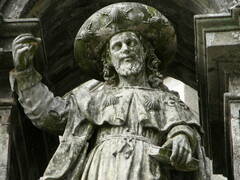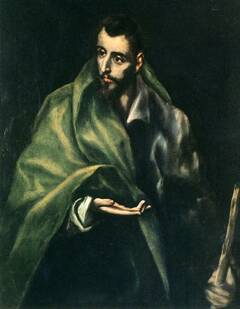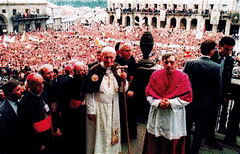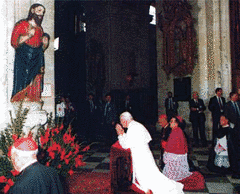The Apostle St James the Greater - Santiago
The first of the Twelve Apostles to be martyred
Son of Zebedee, brother of Saint John
Born in Bethsaida, Galilee; died in 44 AD in Judea
Major Shrine: Cathedral of Santiago de Compostela, Spain
Patron Saint of Pilgrims
Patron saint of the Parish of Medjugorje
Feast Day - 25th July
3 2us by Fr Javier Igea ![]()
"After Christ sent his apostles to the end of the world, St James came to the end of the world which was thought in those times to be in North Western coast of Spain. The city of Santiago where his tomb now is is one of the main sanctuaries of Christianity, a place of pilgrimage .. Pope John Paul said that Santiago and the Camino was a prominent part in the construction of Europe .. To say Santiago is the same as to say to become a pilgrim, to pilgrimage .. Life is a pilgrimage, a pilgrim has to travel with a very light backpack .. somebody who goes through, who is weak, who goes through dangers .. All these symbols are symbols for life. We cannot carry many things in our life, we have to love God above every other thing. . A true pilgrim in life has to be poor, has only to put what is needed in his life which is the love of God our Saviour, a pilgrim should always be moving, in spiritual life we say that a pilgrim cannot stop growing, cannot say 'It is enough, I am not going to continue walking, I have loved enough, I do not need to grow in love' ..that is not going to the goal of our pilgrimage which is the greater Love."
Catechesis by Pope Benedict XVI 
General Audience, Wednesday 21 June 2006 - also in Croatian, French, German, Italian, Portuguese & Spanish
"Dear Brothers and Sisters,
We are continuing the series of portraits of the Apostles chosen directly by Jesus during his earthly life. We have spoken about St Peter and his brother Andrew. Today we meet the figure of James. The biblical lists of the Twelve mention two people with this name: James son of Zebedee and James son of Alphaeus (cf Mk 3, 17,18; Mt 10, 2-3), who are commonly distinguished by the nicknames James the Greater and James the Lesser. These descriptions are certainly not meant to measure their holiness, but just to take note of the different emphasis they receive in the writings of the New Testament and, in particular, within the framework of Jesus' earthly life. Today we will devote our attention to the first of these two characters with the same name.
The name James is the translation of Iákobos, the Greek form of the name of the famous patriarch Jacob. The Apostle of this name is the brother of John and, in the lists mentioned, occupies second place immediately after Peter, as in Mark (3, 17), or in third place after Peter and Andrew in the Gospels of Matthew (10, 2) and Luke (6, 14), while in Acts he comes after Peter and John (1, 13). This James belongs, together with Peter and John, to the group of three privileged disciples who were admitted by Jesus into important moments of his life.
Since it is very hot, I would like to abbreviate and mention here only two of these occasions. He was able to participate, together with Peter and John, in the moment of Jesus' agony in the Garden of Gethsemane and in the event of Jesus' Transfiguration. These then are situations very different from each other: in the one case, James together with the other two Apostles experiences the glory of the Lord, he sees him in conversation with Moses and Elijah, he sees the divine splendour shining forth in Jesus; in the other case, he finds himself in front of suffering and humiliation, he sees with his own eyes how the Son of God humbles himself, making himself obedient unto death. Certainly the second experience is an opportunity for him to mature in faith, to correct the unilateral, triumphalist interpretation of the first experience: he had to glimpse that the Messiah, awaited by the Jewish people as a victor/, in reality was not only surrounded by honour and glory, but also by affliction and weakness. The glory of Christ is realised precisely in the Cross, in participation with our sufferings.
This maturation in faith was brought to completion by the Holy Spirit at Pentecost, so that James, when the moment of supreme witness came, did not back down. In the early 40s of the first century King Herod Agrippa, grandson of Herod the Great, as Luke informs us, "began to persecute some members of the Church, and had James the brother of John killed by the sword" (Acts 12, 1-2). The brevity of the news, devoid of any narrative detail, reveals, on the one hand, how normal it was for Christians to witness to the Lord with their own lives and, on the other, how James had a prominent position in the Church of Jerusalem, also on account of the role he played during Jesus' earthly existence. A later tradition, dating back at least to Isidore of Seville, recounts a stay of his in Spain to evangelize that important region of the Roman Empire. According to another tradition, it was instead his body that was transported to Spain, to the city of Santiago de Compostela. As we all know, that place became the object of great veneration and is still the destination of numerous pilgrimages, not only from around Europe but the whole world. This explains the iconographical representation of St James with the pilgrim's staff and the scroll of the Gospel in his hand, characteristics of the itinerant Apostle dedicated to the announcement of the "Good News", characteristics of the pilgrimage of Christian life.
We can thus learn many things from St James: promptness in welcoming the Lord's call even when he asks us to leave the "boat" of our human securities, enthusiasm in following him on the roads that He indicates to us beyond any of our illusory presumption, readiness to witness to him with courage, if necessary, all the way to the supreme sacrifice of life. Thus James the Greater stands before us as an eloquent example of generous adherence to Christ. He who initially, through his mother, had requested to be seated with his brother next to the Master in his Kingdom, was precisely the first to drink the chalice of the passion, to share martyrdom with the Apostles.
And, in the end, summarizing everything, we can say that the pathway, not only exterior but above all interior, from the mount of the Transfiguration to the mount of the Agony, symbolizes the whole pilgrimage of Christian life, amid the persecutions of the world and the consolations of God, as the Second Vatican Council says. By following Jesus like St James, we know, even in difficulties, that we are going on the right road."
Prayer of Pope Saint John Paul II
at WYD/JMJ Santiago de Compostela 1989
- in English, Italian & Spanish
"Saint James,
for this pilgrimage of ours we need
your zeal and courage.
For this reason, to ask them of you, we have come
as far as this "finisterrae" of your apostolic adventures.
Teach us, apostle and friend of Our Lord,
the WAY which leads to him.
Open us, preacher of the lands of Spain,
to the TRUTH your learned from the Master's lips.
Give us, witness of the Gospel,
the strength always to love the LIFE .
Place yourself, patron of pilgrims,
at the head of our Christian youthful pilgrimage.
And just as, in the past, the peoples walked towards you,
may you be a pilgrim with us when we go to meet all peoples.
With you, St James, Apostle and Pilgrim,
we want to teach the nations of Europe and the world
that Christ is - today and always -
the WAY, the TRUTH and the LIFE."
The martyrdom of Saint James the apostle
- by Eusebius of Caesarea, in Ecclesiastical History, II, 3, 9
With the powerful cooperation of Heaven the whole world was suddenly lit by the sunshine of the saving word. At once, in accordance with holy Scriptures, the voice of its inspired evangelists and apostles went forth into all the earth, and “their words to the ends of the world” (Ps 19[18]:5). In every town and village, like a well-filled threshing floor, churches shot up, bursting with eager members...
At the time of Claudius, King Herod made a determined attack on certain members of the Church, killing James the brother of John with the headsman's sword. Referring to this James, Clement [of Alexandria] tells an interesting story on the strength of an authentic tradition. It appears that the man who brought him into court was so moved when he saw him testify that he confessed that he, too, was a Christian. So they were both taken away together, and on the way he asked James to forgive him. James thought for a moment; then he said: “I wish you peace” and kissed him. So both were beheaded at the same time.
Then, as we read in the sacred record, Herod, seeing how his action in putting James to death had given satisfaction to the Jews, laid hands on Peter as well, clapped him in prison, and was on the very point of perpetrating his murder too but for divine intervention. In the night an angel stood before him and he was miraculously released from his fetters and set free for the ministry of preaching (Acts 12:4-17).



